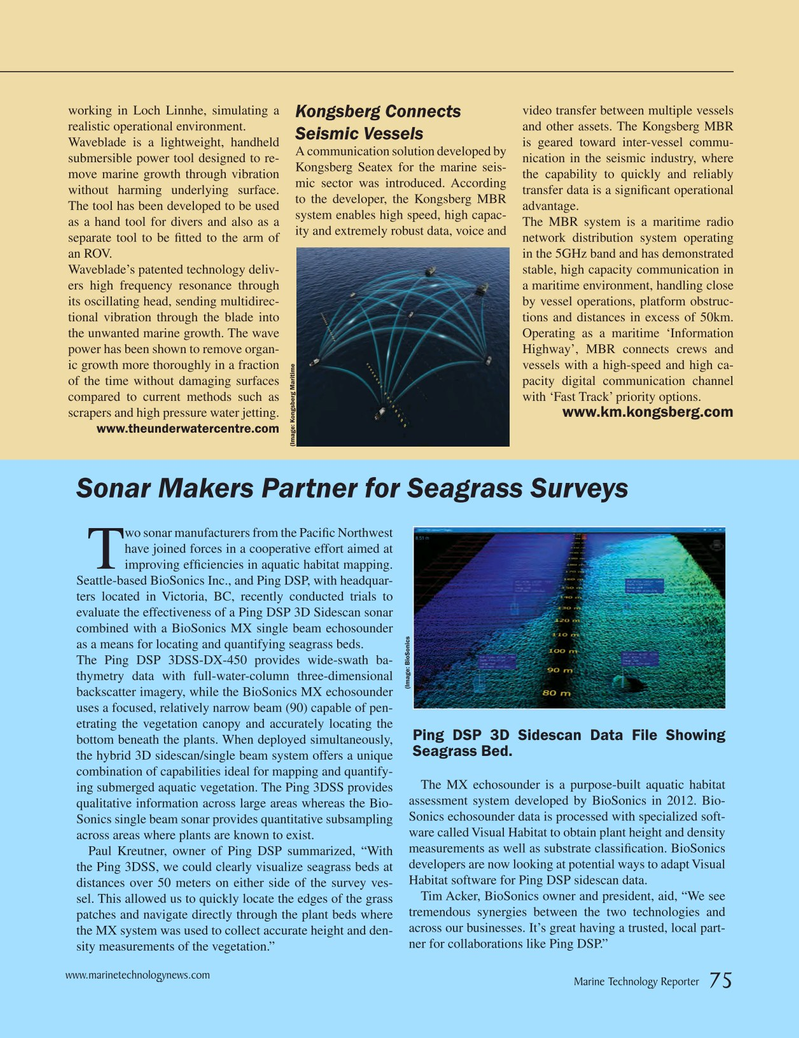
Page 75: of Marine Technology Magazine (March 2015)
Oceanographic Instrumentation: Measurement, Process & Analysis
Read this page in Pdf, Flash or Html5 edition of March 2015 Marine Technology Magazine
working in Loch Linnhe, simulating a video transfer between multiple vessels
Kongsberg Connects realistic operational environment. and other assets. The Kongsberg MBR
Seismic Vessels
Waveblade is a lightweight, handheld A communication solution developed by is geared toward inter-vessel commu- submersible power tool designed to re- nication in the seismic industry, where move marine growth through vibration Kongsberg Seatex for the marine seis- the capability to quickly and reliably without harming underlying surface. mic sector was introduced. According transfer data is a signi? cant operational
The tool has been developed to be used to the developer, the Kongsberg MBR advantage.
as a hand tool for divers and also as a system enables high speed, high capac-
The MBR system is a maritime radio separate tool to be ? tted to the arm of ity and extremely robust data, voice and network distribution system operating an ROV. in the 5GHz band and has demonstrated
Waveblade’s patented technology deliv- stable, high capacity communication in ers high frequency resonance through a maritime environment, handling close its oscillating head, sending multidirec- by vessel operations, platform obstruc- tional vibration through the blade into tions and distances in excess of 50km. the unwanted marine growth. The wave Operating as a maritime ‘Information power has been shown to remove organ- Highway’, MBR connects crews and ic growth more thoroughly in a fraction vessels with a high-speed and high ca- of the time without damaging surfaces pacity digital communication channel compared to current methods such as with ‘Fast Track’ priority options. scrapers and high pressure water jetting. www.km.kongsberg.com www.theunderwatercentre.com (Image: Kongsberg Maritime
Sonar Makers Partner for Seagrass Surveys wo sonar manufacturers from the Paci? c Northwest have joined forces in a cooperative effort aimed at
Timproving ef? ciencies in aquatic habitat mapping.
Seattle-based BioSonics Inc., and Ping DSP, with headquar- ters located in Victoria, BC, recently conducted trials to evaluate the effectiveness of a Ping DSP 3D Sidescan sonar combined with a BioSonics MX single beam echosounder as a means for locating and quantifying seagrass beds.
The Ping DSP 3DSS-DX-450 provides wide-swath ba- thymetry data with full-water-column three-dimensional (Image: BioSonics backscatter imagery, while the BioSonics MX echosounder uses a focused, relatively narrow beam (90) capable of pen- etrating the vegetation canopy and accurately locating the
Ping DSP 3D Sidescan Data File Showing bottom beneath the plants. When deployed simultaneously,
Seagrass Bed.
the hybrid 3D sidescan/single beam system offers a unique combination of capabilities ideal for mapping and quantify-
The MX echosounder is a purpose-built aquatic habitat ing submerged aquatic vegetation. The Ping 3DSS provides assessment system developed by BioSonics in 2012. Bio- qualitative information across large areas whereas the Bio-
Sonics single beam sonar provides quantitative subsampling Sonics echosounder data is processed with specialized soft- ware called Visual Habitat to obtain plant height and density across areas where plants are known to exist.
Paul Kreutner, owner of Ping DSP summarized, “With measurements as well as substrate classi? cation. BioSonics the Ping 3DSS, we could clearly visualize seagrass beds at developers are now looking at potential ways to adapt Visual
Habitat software for Ping DSP sidescan data.
distances over 50 meters on either side of the survey ves-
Tim Acker, BioSonics owner and president, aid, “We see sel. This allowed us to quickly locate the edges of the grass patches and navigate directly through the plant beds where tremendous synergies between the two technologies and across our businesses. It’s great having a trusted, local part- the MX system was used to collect accurate height and den- ner for collaborations like Ping DSP.” sity measurements of the vegetation.” www.marinetechnologynews.com
Marine Technology Reporter 75
MTR #2 (66-80).indd 75 MTR #2 (66-80).indd 75 3/8/2015 2:00:47 PM3/8/2015 2:00:47 PM

 74
74

 76
76
